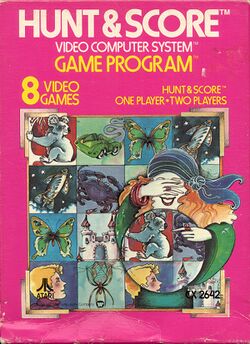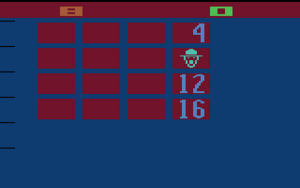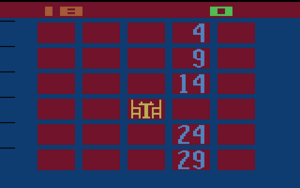
| Hunt & Score | |
|---|---|
| Developer(s) | Atari |
| Publisher(s) | Atari |
| Year released | 1978 |
| System(s) | Atari 2600 |
| Genre(s) | Board game |
|---|---|
| Players | 1-2 |
| Modes | Single player, Multiplayer |
| Input | Keypads |
Hunt & Score was one of the eleven Atari 2600 titles that were part of the second wave of games released in 1978. It is based entirely around the card game commonly known Concentration, in which a player turns over two face down cards with the hopes of finding a matching pair. It is one of the first games to utilize the Atari Keypad controller.
This game was released as Memory Match under the Sears Telegames label. In 1980, Atari retitled the game as A Game of Concentration, in order to capture its gameplay and presumably to boost sales of the cartridge.
Controls[edit]
- Color/BW: Switch between color display and black & white display. (This feature made the game look better on black & white TVs that were still prominent at the time of the game's release.)
- Difficulty Switches: Players whose difficulty switch is set to "b" earn 2 points for each correct guess, while those whose difficulty switch is set to "a" earn only 1 point for each correct guess.
- Game Select: Select a game variation. The variations cycle from 1 to 8 and start back over at 1. See the Game Variation section below.
- Game Reset: Starts a new game in whatever game variation is currently selected. All of the cards will be returned to the table face down, and all players points are reset to 0.
- Keypad: Use the keypad controller to key in the card which you would like to flip over. One or two digit numbers may be entered based on the availability of the cards in play. The number you type appears at the top of the screen. If you wish to type in a two digit number, type the tens digit first, followed by the singles digit. Note that in a 16 card game, you cannot input numbers higher than 16. Likewise, in a 30 card game, no input over 30 is possible. Press * to erase your most recent button press. Press # to select the entered number as your guess. The left keypad controls the first player and the right keypad controls the second player.
How to play[edit]

Every square in play has a number associated with it. All numbers are shown on top of the card, one column at a time. Each player must enter two numbers as guesses which indicate the card that they would like to turn over. In a one player game, the player enters their two guesses every turn, whereas in a two player game, each player takes turns entering their two guesses.
When the two guesses are entered, the face side of each card is shown. If the cards match (or, if wild cards are in play and one of the cards turned was a wild card,) a sound indicates that a match was made and player receives two points (or one point if the difficulty switch is set to "a"). Then the two selected cards will be removed from the table, and the successful player will receive another turn. If the cards did not match, a different sound is made to indicate failure, and the cards are returned to the table face-down. In a two player game, it will become the next player's turn. In a single player game, a wrong guess will be tallied.
Game Variations[edit]
| Type | 16-SQ (4 x 4) | 30-SQ (5 x 6) | ||||||
|---|---|---|---|---|---|---|---|---|
| Game Number | 1 | 2 | 3 | 4 | 5 | 6 | 7 | 8 |
| Number of Players | 1 | 2 | 1 | 2 | 1 | 2 | 1 | 2 |
| Wild Cards | No | No | Yes | Yes | No | No | Yes | Yes |

Hunt & Score can be played in eight different ways, based on three different distinctions:
- Whether there are one or two players playing the game. In a two player game, players compete to make the greater number of correct guesses. In a single player game, the player is attempting to comlpete the table with the fewest number of incorrect guesses.
- Whether you play with a 16 card (4 x 4) arrangement or a 30 card (5 x 6) arrangement. In the 16 card arrangement, there are 8 different pairs of items, while in the 30 card arrangement, there are 15 different pairs of items.
- Whether Wild cards are included. If Wild card are present, revealing one of the wild cards automatically results in a successful guess, making it much easier to earn points. (Note that the computer will prevent uneven pairs from showing up as a result of two wild cards being used on two different objects.)